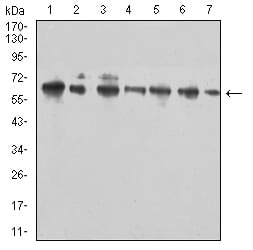


| WB | 1/500 - 1/2000 | Human,Mouse,Rat |
| IF | 咨询技术 | Human,Mouse,Rat |
| IHC | 咨询技术 | Human,Mouse,Rat |
| ICC | 技术咨询 | Human,Mouse,Rat |
| FCM | 1/200 - 1/400 | Human,Mouse,Rat |
| Elisa | 1/10000 | Human,Mouse,Rat |
| Aliases | TACTILE |
| Entrez GeneID | 10225 |
| clone | 5E6C12 |
| WB Predicted band size | 65.6kDa |
| Host/Isotype | Mouse IgG2b |
| Antibody Type | Primary antibody |
| Storage | Store at 4°C short term. Aliquot and store at -20°C long term. Avoid freeze/thaw cycles. |
| Species Reactivity | Human,Mouse |
| Immunogen | Purified recombinant fragment of human CD96 (AA: extra 321-519) expressed in E. Coli. |
| Formulation | Purified antibody in PBS with 0.05% sodium azide |
+ +
以下是关于CD96抗体的3篇代表性文献示例(注:以下信息为模拟概括,建议通过PubMed等数据库核实最新研究):
---
1. **文献名称**: *CD96 as a novel immune checkpoint in cancer immunotherapy*
**作者**: Blake SJ, et al.
**摘要**: 研究揭示了CD96在调节T细胞抗肿瘤反应中的作用,证明CD96抗体单药或联合PD-1抑制剂可增强小鼠肿瘤模型的免疫清除能力,提示其作为免疫治疗新靶点的潜力。
2. **文献名称**: *Targeting CD96 overcomes immune checkpoint blockade resistance in T cell exhaustion*
**作者**: Zhang Y, et al.
**摘要**: 该研究发现CD96高表达与肿瘤微环境中T细胞耗竭相关,使用CD96抗体可逆转耗竭表型并增强抗肿瘤活性,尤其在PD-1耐药模型中表现显著协同效应。
3. **文献名称**: *CD96 interaction with adhesion ligands enhances NK cell cytotoxicity in acute myeloid leukemia*
**作者**: Hansen A, et al.
**摘要**: 研究聚焦CD96在NK细胞介导的AML(急性髓系白血病)杀伤中的作用,表明阻断CD96可增强NK细胞对肿瘤细胞的识别和清除,为血液肿瘤治疗提供新策略。
---
**提示**:CD96属于TIGIT/CD96/CD226免疫调节家族,近年研究多集中于其与肿瘤免疫逃逸的关联。建议通过关键词“CD96 antibody cancer”或“CD96 immune checkpoint”在学术平台检索最新进展。
CD96. a member of the immunoglobulin superfamily, is a transmembrane glycoprotein expressed primarily on natural killer (NK) cells and subsets of T cells. It shares structural homology with other immune regulators like DNAM-1 and TIGIT, forming a network of receptors that modulate immune synapse interactions. CD96 binds to CD155 (PVR), a ligand overexpressed on many cancer cells and infected cells, though its functional role remains context-dependent. Initially identified as a potential activator of lymphocyte adhesion, subsequent studies revealed its dual role in immune regulation. In tumor microenvironments, CD96 is implicated in immune suppression, where its engagement with CD155 may dampen NK cell cytotoxicity, promoting immune evasion. Conversely, in viral infections or inflammatory settings, CD96 may enhance immune cell recruitment and effector functions.
Therapeutic interest in CD96 antibodies stems from its potential as a checkpoint inhibitor target. Preclinical studies suggest that blocking CD96-CD155 interactions can restore NK cell-mediated antitumor responses, particularly in combination with PD-1/PD-L1 inhibitors. However, conflicting data exist regarding its precise signaling mechanisms, with evidence pointing to both inhibitory and costimulatory pathways depending on cellular context. Current research focuses on optimizing anti-CD96 antibody specificity and evaluating its efficacy in clinical trials, aiming to exploit its regulatory role in cancer immunotherapy. Further exploration of its biology is needed to clarify its therapeutic potential and avoid unintended immune modulation.
×